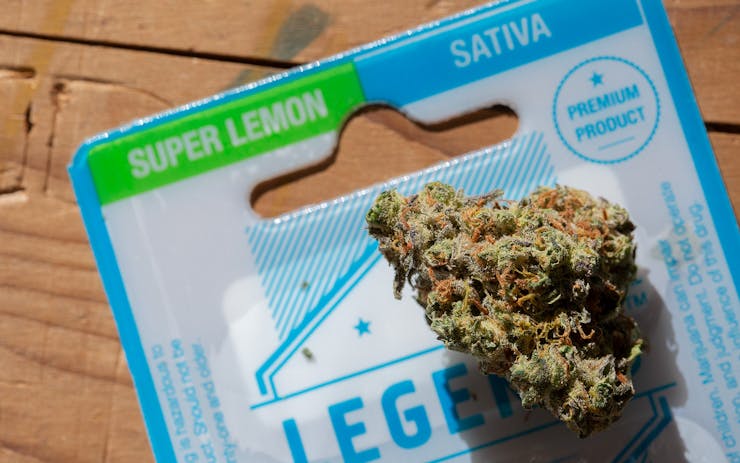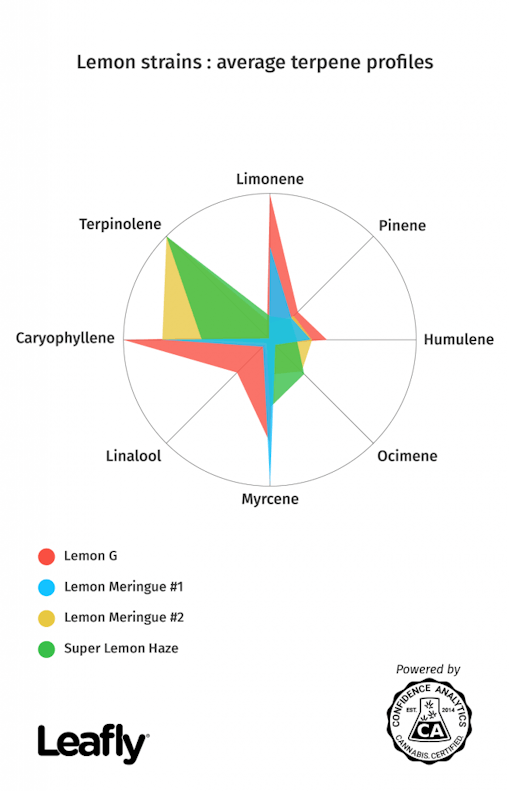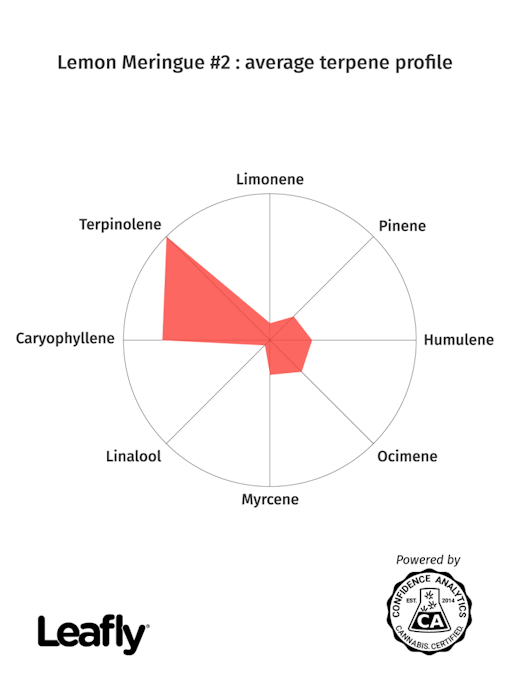In this series, Leafly explores what makes each family of strains unique based on their terpene profiles. A strain “family” refers to a line of hybrids branching from one genetic matriarch that expresses unique and desirable characteristics that breeders seek to build upon. This introductory primer will help you learn a little more about cannabis breeding and strain variability.
What came first: lemon or limonene? Lemon-named cannabis strains tend to have a citrus aroma and flavor, so it’s natural to assume that most, or even all strains in the “Lemon” family contain high levels of the terpene limonene, a compound commonly associated with citrus aromas and stress relief.
It’s the taste of citrus reminds you of bright summer days. It’s the color yellow that you associate with #feelgood vibes. If you’re looking for an uplifting, limonene-fueled high, it makes sense to assume that Lemon strains will provide you with this coveted and cheery terpene.
But are all lemon-scented strains high in limonene? To find out, we looked at verified lab data from trusted Confidence Analytics.
Turns out, not all Lemon strains reflect a limonene-dominant terpene profile.
In the figure above, you’ll find the terpene profiles of four Lemon strains compared: Lemon G, Lemon Meringue (two different chemical expressions, or “phenotypes,” of the strain), and Super Lemon Haze. The points extend toward the terpenes that are most abundant in each strain. A closer look at these terpene profiles will show that none of these strains are, on average, limonene-dominant.
Although these are just four examples, it demonstrates that Lemon strains can express notably different terpene profiles—and therefore, potentially different experiences. So if the experience of these strains aren’t all driven by limonene dominance, which other terpenes influence them? Let’s find out.
Lemon G
Lemon G is a G13 hybrid that is said to deliver upbeat, euphoric, and giggly effects. Though its average terpene profile appears limonene-dominant, it actually has a tad bit more caryophyllene in it. Caryophyllene is known for having potential stress-relieving effects, and combined with limonene, it’s easy to see why so many consumers look to Lemon G for improved moods.
Find Lemon G Nearby
Lemon Meringue #1
Lemon Meringue #1 is the first phenotype of Lemon Meringue, a sweet, zestful cross of Lemon Skunk and Cookies and Cream. On average, this phenotype is myrcene-dominant with terpenes caryophyllene and limonene trailing behind. So if you try Lemon Meringue #1 expecting an uplifting, limonene-driven experience, know that you could potentially experience heavier, more sedative effects.
Shop highly rated dispensaries near you
Showing you dispensaries nearAfter all, Lemon Meringue #1’s terpene profile looks a whole lot like those of the potent powerhouse “Cookies” strains, which are known to be knock-outs.
Find Lemon Meringue Nearby
Lemon Meringue #2
The second phenotype of Lemon Meringue is, on average, terpinolene-dominant with very little hints of limonene at all. While Lemon Meringue #1 expresses terpenes similar to “Cookies” hybrids, this phenotype looks more like Dutch Treat and Snowcap—strains famous for their bright and uplifting euphoria.
This provides a perfect illustration of why names alone aren’t enough to prove what compounds compose a strain. Without verified lab testing to show which terpenes guide the Lemon Meringue experience waiting for you in your stash jar, you’ll have no clue which compounds are about to slow-dance with your endocannabinoid system.
Find Lemon Meringue Nearby
Super Lemon Haze
Super Lemon Haze is one of my favorite strains to wake-and-bake with, thanks to its pleasantly uplifting effects. But surprisingly, this strain doesn’t produce limonene in abundance. Like Lemon Meringue #2, Super Lemon Haze is terpinolene-dominant with caryophyllene and myrcene following in tow.
Find Super Lemon Haze Nearby
So all in all, what does this tell us in reference to Lemon-named strains, their terpenes, and the experience we should expect from them? It tells us that unless a producer provides testing data, you’ll have to rely on guesswork and expectations to determine what sort of experience a strain will provide.
What’s really in a cannabis strain? The conversation around this question is getting louder and louder, and it’d benefit each and every cannabis consumer to open their ears, mind, and lungs to it. Your body, your favorite terpenes, your desired experience… It’s all tied together, and it matters.










